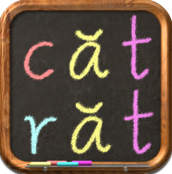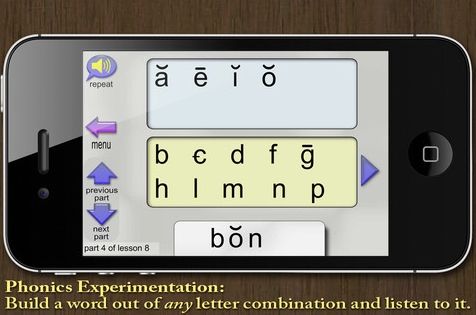
Holden recently got to try out the awesome Phonics and Reading with McGuffey App for iPad by LiteracySoft.
WHAT IS IT?:

Phonics and Reading with McGuffey App for iPad is a wonderful beginning reading program that teaches with phonics. The app is available for PC, Mac, and Apple iOS devices. It is flexible enough to be used to teach adult learners, homeschoolers, dyslexic readers, or ESOL students. It is guaranteed to bring the user’s reading ability to a first grade level.
This app uses a combination of sound, sight, and motion to appeal to a wide variety of learning styles. The program is based on the classic McGuffey’s Eclectic Primer Revised Edition.
The program is self-paced, allowing students to slow down, repeat lessons, or progress as they gain confidence in their mastery of the material.
 This app includes:
This app includes:
- All 52 McGuffey Primer lessons
- All 44 letter sounds of English and their graphemes
- 60+ letter sound animations
- 400+ practice word vocabulary
- 9000+ nonsense word audio dictionary
You can try out the Lite version of the app for free. It contains only the first 10 lessons, but it’s a great way to try it out and see if it works for your students.
The full version of this app is available in the iTunes Store for just $19.99.
OUR EXPERIENCE:
This program has lots of great games and features. To start off, you very easily set up your students by inputting their names and saving them. You can set up as many as 10 different users and store their progress separately. Then for each user, you can go to the user settings and customize certain features such as whether or not to hide the previous and next lesson arrows (which can keep your student from skipping lessons), skip verbose phonics rules explanations (in case your student already knows them or is not ready to benefit from hearing them), opt out of sounding out words in the phonics blender (in case your student is beyond needing that help), opt in to using conservative phonics flash card sound effects (in case your student has sensory issues), opt in to using Open Dyslexic font, or use monochrome letters in words and sentences. So as you can see, this program is truly set up to accommodate the needs of a variety of users.
You can begin lessons at the beginning, or you can select the starting point where you want to begin. I had Holden start at the beginning, even though we’d covered all of the letter sounds and a
Most of the lessons have 13-15 parts that incorporate about 8 different activities, and there are 52 lessons in all. That’s a lot of material to cover! The first part of each lesson introduces some phonetic sounds. They are shown on the screen, and you simply touch them to hear them spoken, see them shown at the beginning of a word, and see them demonstrated in an animation with fun sounds.
Part 2 of each lesson shows you some words. It instructs you to touch each word, listen carefully, and say them out loud. When you tap the words, the program shows the coding of the vowels and then sounds out the words for you.
Part 3 of each lesson names a phonetic sound and has you touch the correct letters that make that sound from a choice of two responses. If you are incorrect, it says the sound of that letter and simply tells you that you are incorrect. If you do it correctly, you are rewarded with a fun and often silly animation with fun sounds. Holden absolutely loved this part! Every time I heard him belly laughing as hard as he could, I knew he had gotten a right answer, and he’d come running to show me the silly things that popped up on the screen for him! He never stopped playing in the middle of this activity because it was just too entertaining for him! ![]()
 Part 4 of each lesson is a phonics blender. You are given a box with vowels and a box with consonants, plus a box at the bottom of the screen with spots to drag your letters to spell either real or nonsense words. The program has over 400 vocabulary words and over 9000 nonsense words built into it, so the possibilities there are endless from the student’s perspective. Holden had a little too much fun making up silly “words” here! In case you haven’t figured it out yet, he enjoys the silly things in life!
Part 4 of each lesson is a phonics blender. You are given a box with vowels and a box with consonants, plus a box at the bottom of the screen with spots to drag your letters to spell either real or nonsense words. The program has over 400 vocabulary words and over 9000 nonsense words built into it, so the possibilities there are endless from the student’s perspective. Holden had a little too much fun making up silly “words” here! In case you haven’t figured it out yet, he enjoys the silly things in life!
Part 5 of each lesson just gives you pictures that represent words you learned in that lesson so you can say the names of the pictures and recognize them as vocabulary words you’ve learned to read so far.
The next series of parts provides reading practice. I really liked this part! You are given phrases and sentences that you should be able to read based on the lessons you’ve covered so far. There is a box underneath each word. I had Holden read each word in the phrase or sentence on his own first and then check to see if he was right by touching the boxes underneath each word to hear them spoken as he went along. If he needed any help, he could touch the word itself and see it coded and hear it sounded out for him. This was great reading practice for him and helped build his confidence as the sentences got longer.
The next activity is a lesson quiz. It shows you the letter sounds and combinations you’ve learned in that lesson and says one of them out loud, asking you to touch the letter that makes that sound. If you are incorrect, it simply asks you to try again. If you are correct, you get a positive sound and a verbal affirmation. At the end of the quiz, if you have missed too many of the questions, it will tell you that you should repeat the lesson before moving on, as each lesson builds on the last. If you pass the quiz, then it congratulates you and tells you to move on to the next activity.
The next activity is a fun spelling practice game where a semi truck drives onto the bottom of the  screen and waits for you to spell the word that is given to you out loud. Your letter choices line the top of the screen, and you spell the given word by dragging the letters into crates on the back of the truck bed. If you drag an incorrect letter, the program rejects the incorrect letter and then helps you by sounding out each letter sound in the word. You try again until you spell it correctly. Then the truck starts its engine and drives off the screen. This repeats until all of the words are completed. Holden really liked this game!
screen and waits for you to spell the word that is given to you out loud. Your letter choices line the top of the screen, and you spell the given word by dragging the letters into crates on the back of the truck bed. If you drag an incorrect letter, the program rejects the incorrect letter and then helps you by sounding out each letter sound in the word. You try again until you spell it correctly. Then the truck starts its engine and drives off the screen. This repeats until all of the words are completed. Holden really liked this game!
The last activity is a train game that gives you practice identifying spoken words. A steam train appears at the bottom of the screen, along with a list of 3 word choices. The game speaks a word to you, and you must correctly identify that word on the screen by touching it. A correct response speeds up the train. An incorrect response slows it down. You must complete four cycles of the game before your current time and your best record time are displayed on the screen. You have the option of playing again to beat your time, or continuing on to the next lesson. This was the only game where Holden sometimes felt a bit frustrated. Sometimes the list of words doesn’t change position, and it speaks the next word as soon as you touch it, so in that split second with the pressure to respond quickly, you might think it didn’t take your response and press it again, giving an incorrect answer. I did this myself when I played it. That makes your train slow down and makes the game take a bit longer to complete. He got so he felt a bit of anxiety whenever he got to the train game, but I just encouraged him to take his time and make sure he was paying attention so he didn’t accidentally tap the wrong word. He’d always accomplish the game in the end, but it wasn’t his favorite by any means.
Holden was always happy to be able to start the next lesson. He’d get excited when he’d learn something new, but also when he’d see something we’d just covered in school so he could practice it. This is a game that he would willingly play again and again. It is a great tool for phonics and reading practice with fun graphics that don’t overpower the learning that it provides. We will definitely continue using it to supplement our phonics instruction, and I have already recommended it to friends with children just learning to read. I encourage you to give it a try and see for yourself! You can always try the free Lite version first and see if your child loves it as much as mine does!
Take a look at what other Crew members had to say about this wonderful app by clicking the banner below.


No comments:
Post a Comment